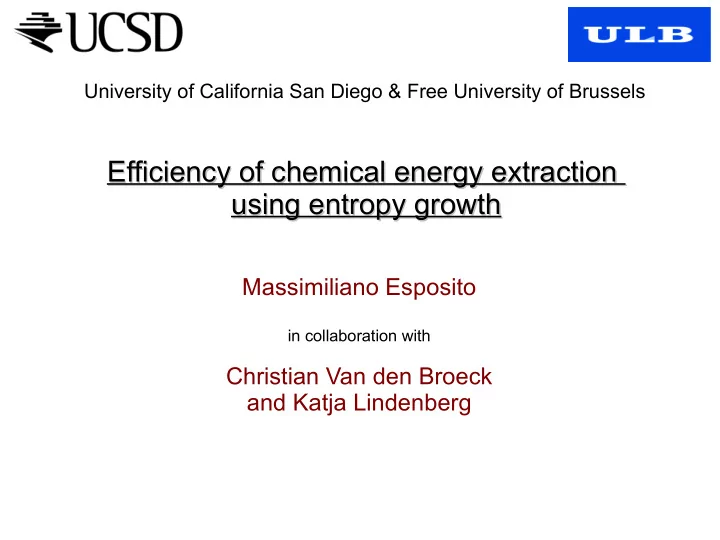

University of California San Diego & Free University of Brussels Efficiency of chemical energy extraction Efficiency of chemical energy extraction using entropy growth using entropy growth Massimiliano Esposito in collaboration with Christian Van den Broeck and Katja Lindenberg
Introduction Efficiency in thermodynamics: transform one form of energy into another Optimal for reversible transformations (importance of strong coupling) however power output is zero! At maximum power and close to equilibrium optimal efficiency is half that of a reversible transformation. [1] C. Van den Broeck, Phys. Rev. Lett. 95 95, 190602, (2005). [2] M. Esposito, K. Lindenberg and C. Van den Broeck, PRL 102 102, 130602 (2009). We will consider chemical energy extraction using the configuration entropy of a growing copolymer. This model has been studied in: [3] C. H. Bennett, BioSystems 11 11, 85 (1979) [4] D. Andrieux and P. Gaspard, PNAS 105 105, 9516 (2008) & J. Chem. Phys. 130 130, 014901 (2009)
Copolymerization model Free enthalpy per monomer
Thermodynamic description Isothermal and isobaric open system: Entropy production Fluxes Affinities
Kinetic description Configuration entropy per monomer Free enthalpy per monomer Entropy production Velocity of polymer growth Probability to insert monomer 1: where
Time rescaling The model has two variables: and Equilibrium: Entropy driven growth Enthalpy driven growth
Power Efficiency Linear regime: Equilibrium: Efficiency at maximum power:
Conclusions Our model illustrates how chemical energy can be extracted from the environment using configuration entropy A regime of linear response exists but fails to accurately describe the efficiency at max power (no universality close to equilibrium) A nonlinear branch occurs far from equilibrium along which entropy production increases while affinity decreases. Power, velocity, efficiency, entropy production become bi-valued functions of the affinity.
Recommend
More recommend